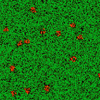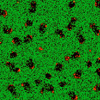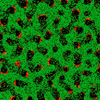 Investigations
Investigations
Jellyfish jumping in
your head
When Jack Cowan read about a theory of
forest-fire dynamics, the professor in mathematics, neurology,
and the Committee on Computational Neuroscience couldn’t
help but notice similarities to his own research on how
nerve cells function in the brain’s neocortex.
The forest-fire model, presented in 1990
by the late Danish theoretical physicist Per Bak and his
collaborators, recognizes trees in three states: green,
burning, and burned. Neurons, Cowan determined in studies
almost 35 years ago, also have three states: quiescent,
or sensitive to stimuli; activated, when they become excited
and produce a pulse; and refractory, recovering from firing
a pulse.
|
| Jack Cowan and Tanya
Baker’s “jellyfish” computer simulation
demonstrates how neurons may fire in the brain’s
neocortex. |
Last spring Cowan applied the forest-fire
model—an example of a dynamic system (along with earthquakes,
traffic flows, and financial markets) that exhibits “self-organized
criticality,” meaning it naturally evolves toward
a critical state—to his mathematical neuron-network
model. He reported his findings at February’s annual
meeting of the American Association for the Advancement
of Science, showing computer simulations of synchronized
activity in neural networks.
In one simulation, which Cowan calls
the “wave” or “spiral” pattern,
curved segments collide and then dissipate. Based purely
on the forest-fire model, the simulation doesn’t include
about one-third of the neocortex’s neurons—inhibitory
ones, which suppress brain activity, preventing excitatory
neurons from firing too rapidly. The forest-fire prototype
would be a more realistic neural model, Cowan realized,
if it included a similar dampening system.
Then physics doctoral student Tanya Baker,
SM’02, who works in Cowan’s computational-neuroscience
group, added inhibitory neurons to the simulation. Rather
than waves, the resulting pattern features tiny coils shooting
forth, like paramecia or jellyfish jumping about—so
Cowan and Baker named it the “jellyfish” pattern.
Both the wave and jellyfish patterns
might occur during normal brain activity, or they may take
place when the brain goes into an altered state. The wave
pattern, Cowan conjectures, may represent what happens during
epileptic seizures, while the jellyfish pattern may be the
stuff of drug-induced hallucinations.
When people take mind-altering drugs,
stare too long at bright light, or experience migraine headaches,
epileptic seizures, or near-death experiences, chemicals
such as serotonin and dopamine are blocked from stimulating
inhibitory neurons. With fewer inhibitors working, too many
excitatory neurons fire, and, as Cowan showed in a March
2001 Philosophical Transactions of the Royal Society of
London study, people actually “see their neural activity
as patterns before their eyes.”
But the patterns the neurons form in
the visual cortex are not the same patterns seen by hallucinators
because of how the eyes are connected to the brain. Parallel
lines in the visual cortex become sucked together, and people
see a spiral or tunnel, while checkerboard or hexagon patterns
in the cortex look like spiralling squares or hexagons.
Now that he’s integrated internal
brain activity such as inhibitors into his neuron-network
model and found the jellyfish behavior, Cowan’s next
step is to apply external stimuli, including simulated visual
patterns, to the model. Of course, the scale on which brain
activity occurs involves thousands of neurons, the details
of which can’t be seen in functional MRI studies or
even in optical images of the exposed neocortex. So Cowan
must rely on his simulations (and the accompanying mathematical
calculations) for insights into the brain’s inner
workings—at least, that is, until technology catches
up with theory.
—A.B.





![]() Advertising
Advertising
![]() About
the Magazine
About
the Magazine ![]() Alumni
Alumni
![]() UChicago
UChicago
![]()
![]() ©2003 The University
of Chicago® Magazine
©2003 The University
of Chicago® Magazine ![]() 5801 South Ellis Ave., Chicago, IL 60637
5801 South Ellis Ave., Chicago, IL 60637![]() fax: 773/702-0495
fax: 773/702-0495 ![]() uchicago-magazine@uchicago.edu
uchicago-magazine@uchicago.edu